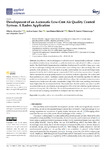Development of an Automatic Low-Cost Air Quality Control System: A Radon Application

Ver/Abrir
Use este enlace para citar
http://hdl.handle.net/2183/27639Colecciones
- Investigación (FIC) [1678]
Metadatos
Mostrar el registro completo del ítemTítulo
Development of an Automatic Low-Cost Air Quality Control System: A Radon ApplicationAutor(es)
Fecha
2021-03-01Cita bibliográfica
Alvarellos, A.; Chao, A.L.; Rabuñal, J.R.; García-Vidaurrázaga, M.D.; Pazos, A. Development of an Automatic Low-Cost Air Quality Control System: A Radon Application. Appl. Sci. 2021, 11, 2169. https://doi.org/10.3390/app11052169
Resumen
[Abstract]
Air pollution is the fourth-largest overall risk factor for human health worldwide. Ambient air pollution (outdoors) and household air pollution (indoors) cause about 6.5 million premature deaths. The World Health Organization has established that between 3% and 14% of lung cancer cases are due to radon gas, making it the most important cause of lung cancer after smoking. This work presents a fully automated, low-cost indoor air quality control system that can monitor temperature, pressure, humidity, total volatile organic compounds (TOVC), and radon concentration. Using the radon concentration as an air quality measure, we created a prediction algorithm. The system uses those predictions to control a ventilation system automatically. We tested the algorithm for different prediction windows and compared the results with those without the ventilation system in a radon research room. In this room, the radon concentration is high 100% of the time, reaching a level eleven times higher than the recommended limit. The results show that the system can achieve an 86% reduction of the radon concentration, maintaining it low 90% of the time while having the ventilation system on during only 34% of the time. This work demonstrates that we can control air quality using low-cost resources, keeping a household or workplace safe but comfortable.
Palabras clave
Air quality
Radon
Low-cost
Airflow
Environmental monitoring
Radon
Low-cost
Airflow
Environmental monitoring
Versión del editor
Derechos
Atribución 4.0 Internacional
ISSN
2076-3417






